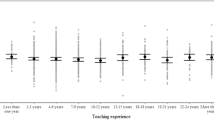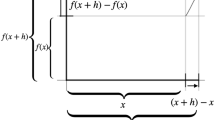Abstract
In this article, we report on the use of a teacher profiling instrument with 62 middle school teachers at the start of a 3-year professional learning programme. The instrument was designed to assess the aspects of teachers’ knowledge identified by Shulman (1987) refined by Ball et al. (2008) and extended to include teachers’ confidence to use and teach various topics in the middle school mathematics curriculum and their beliefs about mathematics teaching and learning. Based on a hierarchical coding of items, the application of the partial credit Rasch model revealed that the profile items were measuring a single underlying construct and suggested that the various facets of teacher knowledge develop together. We describe the characteristics of four levels of the hierarchical construct measuring teacher knowledge and understanding for teaching mathematics in the middle years of schooling, and discuss the unique affordances of a holistic view of teacher knowledge in contrast to considerations of multiple knowledge categories.


Similar content being viewed by others
References
Adams, R. J., & Khoo, S. T. (1996). Quest: Interactive item analysis system. Version 2.1 [computer software]. Melbourne: Australian Council for Educational Research.
Andrich, D. (1978). A rating scale formulation for ordered response categories. Psychometrika, 43, 561–573.
Ball, D. L., & Bass, H. (2000). Interweaving content and pedagogy in teaching and learning to teach: Knowing and using mathematics. In J. Boaler (Ed.), Multiple perspectives on mathematics teaching and learning (pp. 83–104). Westport, CT: Ablex.
Ball, D. L., Thames, M. H., & Phelps, G. (2008). Content knowledge for teaching: What makes it so special? Journal of Teacher Education, 59(5), 389–407.
Beswick, K. (2005). The beliefs/practice connection in broadly defined contexts. Mathematics Education Research Journal, 17(2), 39–68.
Beswick, K. (2007). Teachers’ beliefs that matter in secondary mathematics classrooms. Educational Studies in Mathematics, 65(1), 95–120.
Beswick, K. (2009). School mathematics and mathematicians’ mathematics: Teachers’ beliefs about mathematics. In M. Tzekaki, M. Kaldrimidou, & S. Haralambos (Eds.), Proceedings of the 33rd conference of the international group for the psychology of mathematics education (Vol. 2, pp. 153–160). Thessaloniki: IGPME.
Beswick, K., Watson, J., & Brown, N. (2006). Teachers’ confidence and beliefs and their students’ attitudes to mathematics. In P. Grootenboer, R. Zevenbergen, & M. Chinnappan (Eds.), Identities, cultures and learning spaces: Proceedings of the 29th annual conference of the mathematics education research group of Australasia (Vol. 1, pp. 68–75). Adelaide: Mathematics Education Research Group of Australasia.
Bond, T. G., & Fox, C. M. (2007). Applying the Rasch model: Fundamental measurement in the human sciences (2nd ed.). Mahwah, NJ: Lawrence Erlbaum.
Callingham, R., & Watson, J. (2004). A developmental scale of mental computation with part-whole numbers. Mathematics Education Research Journal, 16(2), 69–86.
Callingham, R., & Watson, J. (2005). Measuring statistical literacy. Journal of Applied Measurement, 6(1), 19–47.
Chick, H. L., & Pierce, R. (2008). Issues associated with using examples in teaching statistics. In O. Figueras, J. L. Cortina, S. Alatorre, T. Rojano, & A. Sepulveda (Eds.), Proceedings of the joint meeting of PME 32 and PME-NA XXX (Vol. 2, pp. 321–328). Mexico: Cinvestav-UMSNH.
Chick, H. L., Baker, M., Pham, T., & Cheng, H. (2006). Aspects of teachers’ pedagogical content knowledge for decimals. In J. Novotná, H. Moraová, M. Ktátká, & N. Stehlíková (Eds.), Proceedings of the 30th annual conference of the international group for the psychology of mathematics education (Vol. 2, pp. 297–304). Prague: PME.
Ernest, P. (1989). The knowledge, beliefs and attitudes of the mathematics teacher: A model. Journal of Education for Teaching, 15(1), 13–33.
Farmer, J. D., Gerretson, H., & Lassak, M. (2003). What teachers take from professional development. Journal of Mathematics Teacher Education, 6, 331–360.
Fisher, W. P. (1994). The Rasch debate: Validity and revolution in educational measurement. In M. Wilson (Ed.), Objective measurement (Vol. 2, pp. 36–72). Norwood, NJ: Ablex.
Graven, M. (2004). Investigating mathematics teacher learning within an in-service community of practice: The centrality of confidence. Educational Studies in Mathematics, 57, 177–211.
Hill, H. C., Rowan, B., & Ball, D. L. (2005). Effects of teachers’ mathematical knowledge for teaching on student achievement. American Educational Research Journal, 42(2), 371–406.
Hill, H. C., Sleep, L., Lewis, J. M., & Ball, D. L. (2007). Assessing teachers’ mathematical knowledge: What knowledge matters and what evidence counts? In F. K. Lester Jr. (Ed.), Second handbook of research on mathematics teaching and learning (pp. 111–155). Charlotte, NC: Information Age Publishing.
Kanes, C., & Nisbet, S. (1996). Mathematics teachers’ knowledge bases: Implications for teacher education. Asia-Pacific Journal of Teacher Education, 24(2), 159–171.
Keeves, J. P., & Alagumalai, S. (1999). New approaches to measurement. In G. N. Masters & J. P. Keeves (Eds.), Advances in measurement in educational research and assessment (pp. 23–42). Oxford: Pergamon.
Linacre, J. M. (1991). Winsteps Rasch measurement users guide. Chicago: MESA Press. From http://www.winsteps.com/aftp/winsteps.pdf. Retrieved 14 Dec 2007.
Ma, L. (1999). Knowing and teaching elementary mathematics: Teachers’ understanding of fundamental mathematics in China and the United States. Mahwah, NJ: Lawrence Erlbaum Associates.
Masters, G. N. (1982). A Rasch model for partial credit scoring. Psychometrika, 47, 149–174.
Messick, S. (1989). Validity. In R. Linn (Ed.), Educational measurement (3rd ed., pp. 13–103). New York: American Council on Education and Macmillan Publishing Company.
Mewborn, D. S. (2001). Teachers’ content knowledge, teacher education, and their effects on the preparation of elementary teachers in the United States. Mathematics Teacher Education and Development, 3, 28–36.
Organisation for Economic Co-operation, Development. (2004). Learning for tomorrow’s world: First results from PISA 2003. Paris: Author.
Rasch, G. (1980). Probabilistic models for some intelligence and attainment tests. Chicago: University of Chicago Press. (original work published 1960).
Shulman, L. S. (1987). Knowledge and teaching: Foundations of the new reform. Harvard Educational Review, 57(1), 1–22.
Stocking, M. L. (1999). Item response theory. In G. N. Masters & J. P. Keeves (Eds.), Advances in measurement in educational research and assessment (pp. 55–63). Oxford: Pergamon.
Watson, J. (2001). Profiling teachers’ competence and confidence to teach particular mathematics topics: The case of chance and data. Journal of Mathematics Teacher Education, 4, 305–337.
Watson, J., & Callingham, R. (2004). Statistical literacy: From idiosyncratic to critical thinking. In G. Burrill & M. Camden (Eds.), Curricular development in statistics education: International Association for Statistical Education roundtable (pp. 116–137). Lund: IASE.
Watson, A., & De Geest, E. (2005). Principled teaching for deep progress: Improving mathematical learning beyond methods and materials. Educational Studies in Mathematics, 58(2), 209–234.
Watson, J. M., Beswick, K., & Brown, N. (2006a). Teacher’s knowledge of their students as learners and how to intervene. In P. Grootenboer, R. Zevenbergen, & M. Chinnappan (Eds.), Identities, cultures and learning spaces: Proceedings of the 29th annual conference of the mathematics education research group of Australasia (Vol. 2). Adelaide: MERGA.
Watson, J. M., Beswick, K., Caney, A., & Skalicky, J. (2006b). Profiling teacher change resulting from a professional learning program in middle school numeracy. Mathematics Teacher Education and Development, 7, 3–17.
Watson, J. M., Beswick, K., Brown, N., & Callingham, R. (2007). Student change associated with teachers’ professional learning. In J. M. Watson & K. Beswick (Eds.), Mathematics, essential research, essential practice: Proceedings of the 30th annual conference of the mathematics education research group of Australasia (Vol. 2, pp. 785–794). Adelaide: MERGA.
Watson, J., Callingham, R., & Donne, J. (2008). Establishing PCK for teaching statistics. In C. Batanero, G. Burrill, C. Reading, & A. Rossman (Eds.), Joint ICME/IASE study: Teaching statistics in school mathematics. Challenges for teaching and teacher education. Proceedings of the ICMI study 18 and the 2008 IASE round table conference. Monterrey, Mexico, July, 2008.
Waugh, R. F. (2002). Creating a scale to measure motivation to achieve academically: Linking attitudes and behaviours using Rasch measurement. British Journal of Educational Psychology, 72, 65–86.
Wilson, M. S., & Cooney, T. J. (2002). Mathematics teacher change and development. In G. C. Leder, E. Pehkonen, & G. Torner (Eds.), Beliefs: A hidden variable in mathematics education (pp. 127–147). Dordrecht: Kluwer.
Wood, T., Williams, G., & McNeal, B. (2006). Children’s mathematical thinking in different classroom cultures. Journal for Research in Mathematics Education, 37(3), 222–255.
Wright, B. (1991). Diagnosing misfit. Rasch Measurement Transactions, 5(2), 156. From http://www.rasch.org/rmt/rmt52k.htm. Accessed 28 June 2009.
Wright, B. D., & Masters, G. N. (1982). Rating scale analysis: Rasch measurement. Chicago: MESA Press.
Zhou, Z., Peverly, S. T., & Xin, T. (2006). Knowing and teaching fractions: A cross-cultural study of American and Chinese mathematics teachers. Contemporary Educational Psychology, 31(4), 438–457.
Acknowledgments
The authors would like to thank Natalie Brown for her valuable contribution to initial discussions of the delineation and naming of levels on the teacher knowledge scale, and Suzie Wright for her assistance with the coding and analysis of the data. This research was funded by Australian Research Council Linkage Grant No. LP0560543.
Author information
Authors and Affiliations
Corresponding author
Rights and permissions
About this article
Cite this article
Beswick, K., Callingham, R. & Watson, J. The nature and development of middle school mathematics teachers’ knowledge. J Math Teacher Educ 15, 131–157 (2012). https://doi.org/10.1007/s10857-011-9177-9
Published:
Issue Date:
DOI: https://doi.org/10.1007/s10857-011-9177-9




